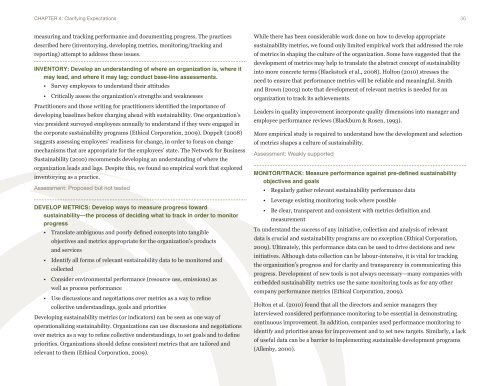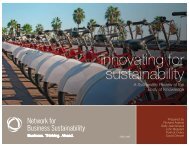embedding sustainability in organizational culture - Network for ...
embedding sustainability in organizational culture - Network for ...
embedding sustainability in organizational culture - Network for ...
Create successful ePaper yourself
Turn your PDF publications into a flip-book with our unique Google optimized e-Paper software.
Chapter 1: 4: Introduction Clarify<strong>in</strong>g expectations<br />
36<br />
measur<strong>in</strong>g and track<strong>in</strong>g per<strong>for</strong>mance and document<strong>in</strong>g progress. The practices<br />
described here (<strong>in</strong>ventory<strong>in</strong>g, develop<strong>in</strong>g metrics, monitor<strong>in</strong>g/track<strong>in</strong>g and<br />
report<strong>in</strong>g) attempt to address these issues.<br />
<strong>in</strong>vEntoRy: develop an understand<strong>in</strong>g of where an organization is, where it<br />
may lead, and where it may lag; conduct base-l<strong>in</strong>e assessments.<br />
• Survey employees to understand their attitudes<br />
• Critically assess the organization’s strengths and weaknesses<br />
Practitioners and those writ<strong>in</strong>g <strong>for</strong> practitioners identified the importance of<br />
develop<strong>in</strong>g basel<strong>in</strong>es be<strong>for</strong>e charg<strong>in</strong>g ahead with <strong>susta<strong>in</strong>ability</strong>. One organization’s<br />
vice president surveyed employees annually to understand if they were engaged <strong>in</strong><br />
the corporate <strong>susta<strong>in</strong>ability</strong> programs (Ethical Corporation, 2009). Doppelt (2008)<br />
suggests assess<strong>in</strong>g employees’ read<strong>in</strong>ess <strong>for</strong> change, <strong>in</strong> order to focus on change<br />
mechanisms that are appropriate <strong>for</strong> the employees’ state. The <strong>Network</strong> <strong>for</strong> Bus<strong>in</strong>ess<br />
Susta<strong>in</strong>ability (2010) recommends develop<strong>in</strong>g an understand<strong>in</strong>g of where the<br />
organization leads and lags. Despite this, we found no empirical work that explored<br />
<strong>in</strong>ventory<strong>in</strong>g as a practice.<br />
assessment: proposed but not tested<br />
dEvElop MEtRicS: develop ways to measure progress toward<br />
<strong>susta<strong>in</strong>ability</strong>—the process of decid<strong>in</strong>g what to track <strong>in</strong> order to monitor<br />
progress<br />
• Translate ambiguous and poorly def<strong>in</strong>ed concepts <strong>in</strong>to tangible<br />
objectives and metrics appropriate <strong>for</strong> the organization’s products<br />
and services<br />
• Identify all <strong>for</strong>ms of relevant <strong>susta<strong>in</strong>ability</strong> data to be monitored and<br />
collected<br />
• Consider environmental per<strong>for</strong>mance (resource use, emissions) as<br />
well as process per<strong>for</strong>mance<br />
• Use discussions and negotiations over metrics as a way to ref<strong>in</strong>e<br />
collective understand<strong>in</strong>gs, goals and priorities<br />
Develop<strong>in</strong>g <strong>susta<strong>in</strong>ability</strong> metrics (or <strong>in</strong>dicators) can be seen as one way of<br />
operationaliz<strong>in</strong>g <strong>susta<strong>in</strong>ability</strong>. Organizations can use discussions and negotiations<br />
over metrics as a way to ref<strong>in</strong>e collective understand<strong>in</strong>gs, to set goals and to def<strong>in</strong>e<br />
priorities. Organizations should def<strong>in</strong>e consistent metrics that are tailored and<br />
relevant to them (Ethical Corporation, 2009).<br />
While there has been considerable work done on how to develop appropriate<br />
<strong>susta<strong>in</strong>ability</strong> metrics, we found only limited empirical work that addressed the role<br />
of metrics <strong>in</strong> shap<strong>in</strong>g the <strong>culture</strong> of the organization. Some have suggested that the<br />
development of metrics may help to translate the abstract concept of <strong>susta<strong>in</strong>ability</strong><br />
<strong>in</strong>to more concrete terms (Blackstock et al., 2008). Holton (2010) stresses the<br />
need to ensure that per<strong>for</strong>mance metrics will be reliable and mean<strong>in</strong>gful. Smith<br />
and Brown (2003) note that development of relevant metrics is needed <strong>for</strong> an<br />
organization to track its achievements.<br />
Leaders <strong>in</strong> quality improvement <strong>in</strong>corporate quality dimensions <strong>in</strong>to manager and<br />
employee per<strong>for</strong>mance reviews (Blackburn & Rosen, 1993).<br />
More empirical study is required to understand how the development and selection<br />
of metrics shapes a <strong>culture</strong> of <strong>susta<strong>in</strong>ability</strong>.<br />
assessment: Weakly supported<br />
MonitoR/tRack: Measure per<strong>for</strong>mance aga<strong>in</strong>st pre-def<strong>in</strong>ed <strong>susta<strong>in</strong>ability</strong><br />
objectives and goals<br />
• Regularly gather relevant <strong>susta<strong>in</strong>ability</strong> per<strong>for</strong>mance data<br />
• Leverage exist<strong>in</strong>g monitor<strong>in</strong>g tools where possible<br />
• Be clear, transparent and consistent with metrics def<strong>in</strong>ition and<br />
measurement<br />
To understand the success of any <strong>in</strong>itiative, collection and analysis of relevant<br />
data is crucial and <strong>susta<strong>in</strong>ability</strong> programs are no exception (Ethical Corporation,<br />
2009). Ultimately, this per<strong>for</strong>mance data can be used to drive decisions and new<br />
<strong>in</strong>itiatives. Although data collection can be labour-<strong>in</strong>tensive, it is vital <strong>for</strong> track<strong>in</strong>g<br />
the organization’s progress and <strong>for</strong> clarity and transparency <strong>in</strong> communicat<strong>in</strong>g this<br />
progress. Development of new tools is not always necessary—many companies with<br />
embedded <strong>susta<strong>in</strong>ability</strong> metrics use the same monitor<strong>in</strong>g tools as <strong>for</strong> any other<br />
company per<strong>for</strong>mance metrics (Ethical Corporation, 2009).<br />
Holton et al. (2010) found that all the directors and senior managers they<br />
<strong>in</strong>terviewed considered per<strong>for</strong>mance monitor<strong>in</strong>g to be essential <strong>in</strong> demonstrat<strong>in</strong>g<br />
cont<strong>in</strong>uous improvement. In addition, companies used per<strong>for</strong>mance monitor<strong>in</strong>g to<br />
identify and prioritise areas <strong>for</strong> improvement and to set new targets. Similarly, a lack<br />
of useful data can be a barrier to implement<strong>in</strong>g susta<strong>in</strong>able development programs<br />
(Allenby, 2000).
















